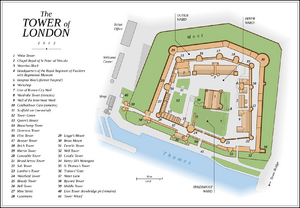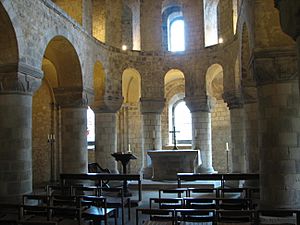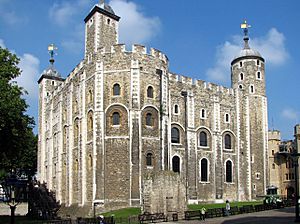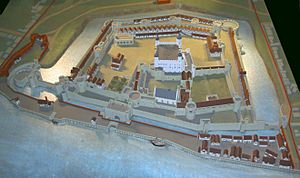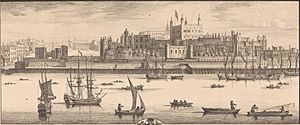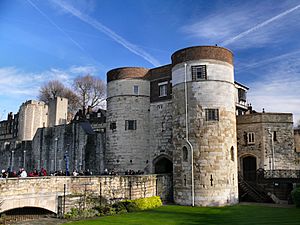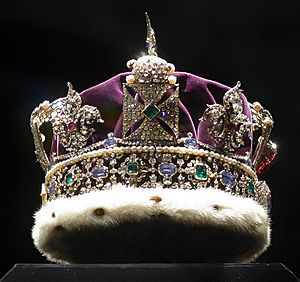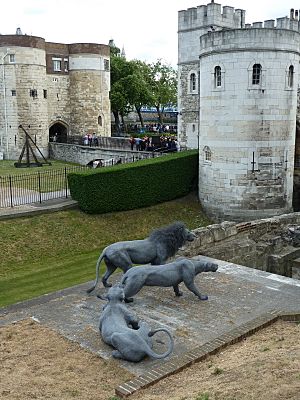Tower of London facts for kids
Quick facts for kids Tower of London |
|
|---|---|
 |
|
| Location | London Borough of Tower Hamlets |
| Area | Castle: 12 acres (4.9 ha) Tower Liberties: 6 acres (2.4 ha) |
| Height | 27 metres (89 ft) |
| Built | White Tower: 1078 Inner Ward: 1190s Re-built: 1285 Wharf expansion: 1377–1399 |
| Visitors | 2,984,499 (in 2019) |
| Owner | Queen Elizabeth II in right of the Crown |
| Type | Cultural |
| Criteria | ii, iv |
| Designated | 1988 (12th session) |
| Reference no. | 488 |
| Country | England |
|
Listed Building – Grade I
|
|
|
Listed Building – Grade II
|
|
| Lua error in Module:Location_map at line 420: attempt to index field 'wikibase' (a nil value). | |
The Tower of London is a famous historic castle in central London. It stands on the north bank of the River Thames. The castle is officially called "Her Majesty's Royal Palace and Fortress of the Tower of London." It was started in late 1066 after the Normans took over England.
The most famous part is the White Tower. William the Conqueror built it in 1078. It was a strong symbol of the new rulers' power. The Tower was used as a prison from 1100 until 1952. Many important people were held there. But being a prison was not its main job.
Early on, the Tower was a grand royal home. It is a group of buildings with two rings of defensive walls. A moat (a deep ditch filled with water) surrounds it. Kings like Richard I, Henry III, and Edward I expanded the Tower. This happened mainly in the 12th and 13th centuries. The way it looks today is mostly thanks to their work.
The Tower of London has been very important in English history. It was attacked many times. Controlling the Tower often meant controlling the country. Over time, it has been an armoury (a place for weapons), a treasury (for money), and a menagerie (a zoo). It also housed the Royal Mint (where coins are made) and the Crown Jewels.
For centuries, new kings and queens would travel from the Tower to Westminster Abbey for their coronation. The Constable of the Tower is in charge of the castle when the monarch is not there. This was a very powerful job long ago. In the late 1400s, the Princes in the Tower disappeared mysteriously while staying there. Many believe they were murdered.
During the Tudor period, the Tower was used less as a royal home. Its defenses became old-fashioned for new weapons like cannons. The Tower was most used as a prison in the 1500s and 1600s. Many famous people who lost favor with the king or queen were held there. This included Elizabeth I before she became queen and Sir Walter Raleigh. This is why people say "sent to the Tower".
Even though it has a scary reputation for torture and death, this is mostly from old stories. Only seven people were executed inside the Tower before the 20th century. Most executions happened on Tower Hill nearby. During the First and Second World Wars, the Tower was a prison again. Twelve spies were executed there.
After World War II, the Tower was repaired from bomb damage. It reopened to the public. Today, the Tower of London is a very popular place for tourists. It is looked after by a charity called Historic Royal Palaces. It is also a World Heritage Site, which means it is important to the whole world.
Contents
Exploring the Tower's Design
The Tower was built to be strong and impressive. It faced Saxon London, showing its power. It also stood out to boats on the River Thames. The castle has three main areas, called "wards" or enclosures.
Castle Layout and Wards
The innermost ward holds the White Tower. This is the oldest part of the castle. Around it, to the north, east, and west, is the inner ward. This was built by Richard the Lionheart in the late 1100s. The outer ward surrounds the whole castle. Edward I built it.
Even though the Tower grew over time, its basic shape has been the same since Edward I finished his work in 1285. The castle covers about 12 acres. Another 6 acres around it, called the Tower Liberties, were kept clear for military reasons. The Tower of London did not have a permanent torture chamber. However, a "rack" (a torture device) was kept in the White Tower's basement later on.
The White Tower
The White Tower is a keep, which is the strongest building in a medieval castle. It had rooms for the king or his representative. It is one of the largest keeps in the Christian world. Some call it "the most complete eleventh-century palace in Europe."
The White Tower is about 36 by 32 meters at its base. It is 27 meters tall at the southern battlements (the top walls). It originally had three floors. The entrance was high up on the south side. You reached it by a wooden staircase that could be removed during an attack.
Inside, each floor had three rooms. The largest was on the west side. The chapel was in the south-east corner. It took up the entrance and upper floors. The building had toilets built into the walls. Four fireplaces kept it warm.
The White Tower was built mostly from Kentish rag-stone. Some local mudstone was also used. Stone from Caen in France was used for details. Most of the windows were made larger in the 1700s. Only two original windows remain.
The basement floor was partly underground on the north side. It was used for storage. One room had a well. The basement's inside was mostly changed in the 1700s. It is lit by small slits (narrow openings).
The entrance floor was likely for important officials. The south entrance was blocked in the 1600s and reopened in 1973. The crypt (underground room) of St John's Chapel was in the south-east corner. It could only be reached from the eastern room. A hidden area in the crypt's north wall was probably a strong-room for royal treasures.
The upper floor had a great hall and living quarters. These were originally open to the roof. A gallery was built into the wall. The top floor and the current roof were added in the 1400s. St John's Chapel was not part of the White Tower's first plan. Its simple look today is like it was in the Norman period. In the 1200s, during Henry III's time, the chapel was decorated with gold crosses and stained glass windows.
Innermost Ward: Royal Living Quarters
The innermost ward is south of the White Tower. It stretched to the edge of the River Thames. This area likely had timber buildings from the Tower's start. Royal living quarters moved from the White Tower into this ward by the 1170s. These rooms were updated in the 1220s and 1230s. They became as grand as other royal homes like Windsor Castle.
Construction of Wakefield and Lanthorn Towers began around 1220. These towers were at the corners of the innermost ward's wall along the river. They were probably private homes for the queen and king. Henry III's reign shows how royal rooms were decorated. The queen's room was painted white with flowers. A large hall was built in the south of the ward. Near Wakefield Tower was a private gate for the king.
The innermost ward was once surrounded by a ditch. This ditch was filled in by the 1220s. A kitchen was built in the ward around this time. Between 1666 and 1676, the innermost ward changed a lot. The palace buildings were removed. The area around the White Tower was cleared. The Jewel House was torn down, and the Crown Jewels moved to Martin Tower.
Inner Ward: Strong Defenses
The inner ward was created when Richard the Lionheart dug a moat west of the innermost ward. This doubled the castle's size. Henry III built the east and north walls of this ward. Most of his work still stands. Only two of the nine towers he built have been fully rebuilt.
The innermost ward's wall also acts as a curtain wall for the inner ward. The main entrance was likely a gatehouse in the west wall. This is now the site of Beauchamp Tower. Edward I rebuilt the inner ward's western curtain wall. Beauchamp Tower was one of the first large buildings in Britain to use brick since Roman times.
The inner ward's curtain wall has 13 towers. Moving counter-clockwise from the south-west, they are: Bell, Beauchamp, Devereux, Flint, Bowyer, Brick, Martin, Constable, Broad Arrow, Salt, Lanthorn, Wakefield, and the Bloody Tower. These towers helped defend the castle. They also had living spaces. Bell Tower had a bell to warn of attacks. The royal bow-maker worked in Bowyer Tower. A light on Lanthorn Tower guided boats at night.
Henry's expansion brought the St Peter ad Vincula chapel inside the castle walls. Henry decorated it with glass windows. Edward I rebuilt it, and Henry VIII rebuilt it again in 1519. The current building is from this time.
The Bloody Tower was built near Wakefield Tower. It was a water-gate, allowing access from the River Thames. It had a portcullis (a heavy gate) for protection. It got its name in the 1500s because people believed the Princes in the Tower were murdered there.
During the Tudor period, buildings for storing weapons were built along the north inner ward. In 1663, a new storehouse, now called the New Armouries, was built. The Grand Storehouse was built north of the White Tower in 1688. It burned down in 1841. The Waterloo Block, a former barracks, was built on that site. It now houses the Crown Jewels.
Outer Ward: New Defenses
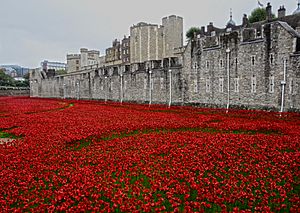
Edward I added a third ward, a narrow area that completely surrounded the castle. He also built Legge's Mount, a strong point at the north-west corner. Brass Mount in the north-east corner was added later. The three rectangular towers on the east wall were removed in 1843. Blocked battlements (parts of the wall with openings) on Legge's Mount are the only original medieval battlements left.
A new 50-meter-wide moat was dug outside the new walls. It was originally 4.5 meters deeper than it is today. The old main entrance was replaced. A new entrance was built in the south-west corner. This complex had two gatehouses and a barbican (a fortified gate). It became known as the Lion Tower because royal animals were kept there. The Lion Tower no longer exists.
Edward also extended the Tower onto land that was once part of the River Thames. He built St Thomas's Tower there between 1275 and 1279. This became known as Traitors' Gate. It replaced the Bloody Tower as the castle's water-gate. This building is special in England. It had arrowslits (narrow openings for archers) to defend against attacks from the river. It also had a portcullis. Luxurious rooms were on the first floor.
Edward also moved the Royal Mint into the Tower. By 1560, it was in a building near Salt Tower. Between 1348 and 1355, another water-gate, Cradle Tower, was added for the king's private use.
The Tower's Beginnings
After winning the Battle of Hastings in 1066, William the Conqueror secured his new lands. He built many castles. When he reached London, he found the bridge defended by Saxon soldiers. He attacked Southwark first, then circled London. In December 1066, London's leaders gave up without a fight.
William built 36 castles between 1066 and 1087. His followers built even more. These castles were used as forts, government centers, and homes. William sent people ahead to prepare London for his arrival. He wanted to "overawe the Londoners" with a new castle. London was the biggest town in England. It was important for the Normans to control it.
The Tower of London was built on the south-east corner of the old Roman town walls. These walls helped protect it. The River Thames added more protection from the south. This first castle was likely surrounded by a ditch and a timber fence. It probably had simple living quarters for William.
Most early Norman castles were made of wood. But by the late 1000s, some, like the Tower of London, were rebuilt in stone. Work on the White Tower probably started in 1078. Gundulf, the Bishop of Rochester, was in charge of building it. It might not have been finished until after William died in 1087. The White Tower is the oldest stone keep in England. It was the strongest part of the early castle. It also had grand rooms for the king.
The White Tower was likely finished by 1100. That year, Bishop Ranulf Flambard was imprisoned there. He was the first recorded prisoner. But he was also the first to escape! He used a smuggled rope hidden in a wine barrel. He was held in comfort and had servants. On February 2, 1101, he held a party for his guards. After they drank a lot, he lowered himself from a hidden room and escaped. People were so surprised that some thought he used magic.
In 1097, King William II ordered a wall built around the Tower. It was probably a stone wall, replacing the timber fence. The Norman takeover changed London. Land was taken and given to Normans. Many Jewish people were also brought over for financial reasons. Jewish communities often lived near castles for royal protection. They used the Tower as a safe place when they were threatened.
Power Struggles and the Tower
When Henry I died in 1135, there was a fight over who would be king. Stephen of Blois quickly took control of London and its Tower. The castle had not been a royal home for a while. It was usually managed by a Constable of the Tower. At this time, Geoffrey de Mandeville held the job.
The Tower was seen as a very strong fortress in an important spot. Mandeville used this to his advantage. He switched his loyalty between Stephen and Empress Matilda to gain power. He became "the richest and most powerful man in England." When he tried to switch sides again, Stephen arrested him. Stephen forced him to give up his castles and replaced him with a loyal supporter.
Before this, the Constable job was passed down in families. But after Mandeville, the king always chose who would be Constable. This person was usually very important. The Constable was in charge of the castle and its soldiers. They also had duties in the city, like collecting taxes and keeping order. In 1191, the job of Lord Mayor of London was created. This took away many of the Constable's city powers.
Expanding the Tower's Defenses
The Tower likely stayed the same until Richard the Lionheart's reign (1189–1199). The castle was expanded by William de Longchamp, who was in charge of England while Richard was on a crusade. Records show that over £2,800 was spent on the Tower in one year. Longchamp dug a moat around the castle. He was preparing for war with Richard's younger brother, Prince John, who wanted to take power.
Longchamp made the Tower as strong as possible. The new defenses were first tested in October 1191. The Tower was attacked for the first time. Longchamp gave up to John after only three days. He decided it was better to surrender.
Royal Building Projects
John became king in 1199. Many of his nobles did not like him. In 1214, Robert Fitzwalter led an army into London and attacked the Tower. The Tower held out, and the attack ended when John signed the Magna Carta. But John broke his promises, starting the First Barons' War. Fitzwalter kept control of London and the Tower. The Tower's soldiers joined the nobles.
John was removed as king in 1216. The nobles offered the throne to Prince Louis of France. But after John died, many supported his son, Prince Henry. Fitzwalter still controlled London and the Tower. They held out until it was clear that Henry's supporters would win.
In the 1200s, Kings Henry III (1216–1272) and Edward I (1272–1307) greatly expanded the castle. They made it look much like it does today. Henry did not get along with his nobles. He wanted the Tower of London to be a very strong fort. He also wanted it to be a comfortable home. Nearly £10,000 was spent on the Tower from 1216 to 1227.
Around 1238, the castle grew to the east, north, and north-west. This work continued through Henry III's and Edward I's reigns. A new defensive wall with towers was built. A defensive ditch was dug on the west, north, and east sides, where the river did not protect the wall. The eastern expansion went beyond the old Roman city wall.
The Tower had long been a symbol of harsh rule. Londoners disliked it. Henry's building plans were not popular. When a gatehouse fell down in 1240, the locals celebrated. The expansion also caused problems for nearby hospitals and churches.
Henry III often held court at the Tower. He held parliament there twice when his nobles were causing trouble. In 1258, unhappy nobles, led by Simon de Montfort, forced the King to agree to changes. This included giving up control of the Tower. Henry did not like losing power. He got permission from the pope to break his promise. With hired soldiers, Henry took back the Tower in 1261. A truce was made, and Henry had to give up the Tower again.
Henry won a big victory in 1265. This allowed him to regain control of the country and the Tower. A cardinal came to England to punish those who were still rebelling. This was unpopular. The situation got worse when the cardinal was given control of the Tower. Gilbert de Clare marched on London in 1267 and attacked the castle. He said the Tower should not be controlled by a foreigner or a church leader. Despite a large army, he could not take the castle. He retreated, and the Tower was peaceful for the rest of Henry's reign.
Edward I spent a lot of money, £21,000, on the Tower between 1275 and 1285. This was more than double what Henry III spent. Edward was an experienced castle builder. He used his knowledge from wars to add new ideas to castle building. At the Tower, Edward filled in Henry III's moat. He built a new wall along its line, creating a new enclosure. A new moat was dug in front of this new wall.
The western part of Henry III's wall was rebuilt. Beauchamp Tower replaced the old gatehouse. A new entrance was created with strong defenses. Edward also added two watermills to make the castle self-sufficient. In 1278, 600 Jewish people were imprisoned in the Tower. They were accused of cutting coins. Persecution of Jewish people began in 1276. It ended in 1290 when Edward forced them out of the country.
The Tower in Later Medieval Times
During Edward II's reign (1307–1327), not much building happened at the Tower. However, the Privy Wardrobe was created. This group was based at the Tower and managed the country's weapons. In 1321, Margaret de Clare, Baroness Badlesmere became the first woman imprisoned in the Tower. She had refused Queen Isabella entry to Leeds Castle.
The Tower was the most important royal prison. It was usually for high-ranking prisoners. But it wasn't always secure. People often bribed guards to escape. In 1322, Roger Mortimer, 1st Earl of March, escaped with help from a guard. He fled to France, met Edward's Queen, and they planned to overthrow the King. Mortimer captured the Tower and freed its prisoners. He ruled for three years. In 1330, Edward III and his supporters captured Mortimer and put him in the Tower.
Under Edward III (1312–1377), England had success in wars against France and Scotland. Many noble prisoners of war were held in the Tower. Edward II had let the Tower fall apart. By Edward III's time, it was uncomfortable. Prisoners could not hunt as they could at other royal prisons. Edward III ordered the castle to be renovated.
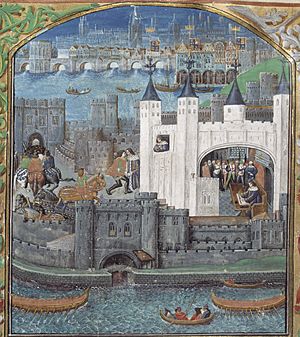
When Richard II was crowned in 1377, he led a procession from the Tower to Westminster Abbey. This tradition lasted until 1660. During the Peasants' Revolt of 1381, the Tower of London was attacked with the King inside. When Richard went to meet the rebel leader, Wat Tyler, a crowd broke into the castle. They looted the Jewel House. The Archbishop of Canterbury, Simon Sudbury, was taken from the chapel and executed on Tower Hill.
Six years later, there was more unrest. Richard spent Christmas safely in the Tower. When Henry Bolingbroke returned from exile in 1399, Richard was imprisoned in the White Tower. He gave up his throne and Bolingbroke became King Henry IV. In the 1400s, little building work happened. But the Tower remained a safe place. When supporters of Richard II tried to take over, Henry IV found safety there.
The Tower also held many important prisoners. The heir to the Scottish throne, later King James I of Scotland, was held there in 1406. Henry V's victories in the Hundred Years' War meant many high-ranking French prisoners were held in the Tower until they were ransomed.
The late 1400s saw the Wars of the Roses. The Tower was attacked again in 1460 by the Yorkist forces. It was damaged by cannons. It surrendered when Henry VI was captured. Henry briefly regained the throne in 1470. But Edward IV soon took control again. Henry VI was imprisoned in the Tower and likely murdered there. During these wars, the Tower was strengthened to resist gunfire.

After Edward IV died in 1483, the famous murder of the Princes in the Tower is believed to have happened. This is one of the most well-known events linked to the Tower. Edward V's uncle, Richard Duke of Gloucester, became Lord Protector because the prince was too young to rule. Stories say 12-year-old Edward and his younger brother Richard were held in the Tower. Richard Duke of Gloucester became King Richard III in July. The princes were last seen in June 1483. It is thought they were murdered later that summer. Bones believed to be theirs were found in 1674. Opposition to Richard grew until he was defeated in 1485 by Henry Tudor, who became King Henry VII.
The Tower's Changing Roles
The Tudor period marked the end of the Tower of London as a main royal home. A chronicler from the 1500s said it became more of "an armouries and house of munition, and thereunto a place for the safekeeping of offenders than a palace roiall for a king or queen to sojourne in". The Yeoman Warders have been the Royal Bodyguard since at least 1509.
During Henry VIII's reign, the Tower's defenses needed a lot of work. In 1532, Thomas Cromwell spent over £3,500 on repairs. But this was not enough for modern artillery. The palace buildings were neglected after Henry's death. They were almost impossible to live in. From 1547, the Tower was only used as a royal home for special events. For example, Edward VI, Mary I, and Elizabeth I stayed there briefly before their coronations.
The Tower as a Prison
In the 1500s, the Tower gained a lasting reputation as a harsh prison. This wasn't always true. As a royal castle, it held people for various reasons. These were usually important people for short times. There were other prisons for common people. Prisoners could make their lives easier by buying things like better food. There was no special prison building until 1687.
The Tower's reputation for torture comes mostly from religious writers in the 1500s and romantic writers in the 1800s. While much of this is exaggerated, the 1500s and 1600s were its busiest time as a prison. Many religious and political prisoners were held there. Torture needed permission from the Privy Council, so it was not used often. Between 1540 and 1640, there were 48 recorded cases of torture. The most common forms were the rack, the Scavenger's daughter, and manacles. The rack was also called the "Duke of Exeter's daughter." Guy Fawkes was tortured at the Tower in 1605. After torture, he confessed to the Gunpowder Plot.
Anne Boleyn was held and executed at the Tower. The Yeoman Warders' main job became looking after prisoners. The Tower was often safer than other London prisons, where disease was common. Important prisoners could live in good conditions. Walter Raleigh had his rooms changed for his family. His son was born there in 1605.
Executions usually happened on Tower Hill, not inside the Tower itself. 112 people were executed on the hill over 400 years. Before the 1900s, seven executions happened inside the castle on Tower Green. This was for prisoners whose public execution was considered too risky, like Lady Jane Grey. After Lady Jane Grey's execution in 1554, Queen Mary I imprisoned her sister Elizabeth (later Queen Elizabeth I) in the Tower. Mary suspected Elizabeth of causing a rebellion.
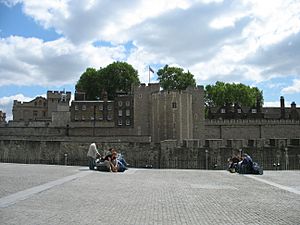
Military and Government Roles
The Office of Ordnance and Armoury Office were founded in the 1400s. They took over managing the monarch's weapons and valuables. Since there was no standing army before 1661, the royal armoury at the Tower was important for getting supplies during war. These groups were at the Tower from at least 1454. By the 1500s, they were in the inner ward. The Board of Ordnance (their successor) had its main office in the White Tower. It used nearby buildings for storage. In 1855, the Board was ended. Its successor moved its headquarters in 1869.
Political problems between Charles I and Parliament in the 1600s led to an attempt by the King's forces to secure the Tower. It held money and weapons. London's militia, the Trained Bands, moved into the castle in 1640. Plans for defense were made. Gun platforms were built. But these preparations were not tested. In 1642, Charles I tried to arrest five members of parliament. When this failed, he fled London. Parliament removed Sir John Byron, the Lieutenant of the Tower. The Trained Bands supported Parliament. They blocked the Tower with London citizens. Byron gave up control of the Tower. Parliament put Sir John Conyers in charge. By the time the English Civil War started in November 1642, Parliament controlled the Tower.
The last king to have a coronation procession from the Tower to Westminster was Charles II in 1660. The castle's rooms were so bad that he did not stay there the night before his coronation. Under the Stuart kings, the Tower's buildings were remodeled. Over £4,000 was spent in 1663 on a new storehouse, now the New Armouries. There were plans to make the Tower's defenses more modern, but they were never carried out. Soldier living quarters were improved in 1670. But general accommodations were still poor.
When the Hanoverian dynasty took the throne, their position was uncertain. The Tower of London was repaired in case of a Scottish rebellion. Old gun platforms had decayed. The number of guns was reduced from 118 to 45. One person at the time said the castle "would not hold out four and twenty hours against an army prepared for a siege." Most repair work in the 1700s was small and unplanned. A new gate was added in 1774.
The moat around the castle had filled with mud over centuries. In 1830, the Constable of the Tower, the Duke of Wellington, ordered a large cleaning. But this did not stop disease in the soldiers in 1841. To prevent more health problems, the moat was drained and filled with earth. This work began in 1843 and finished two years later.
The Waterloo Barracks were built in the inner ward starting in 1845. The Duke of Wellington laid the first stone. This building could house 1,000 men. Separate officers' quarters were also built. The building is now the headquarters of the Royal Regiment of Fusiliers. The Chartist movement (a political movement) in the mid-1800s led to a desire to strengthen the Tower. This was the last major building project for defense. Most of the remaining gun and firearm positions are from this time.
During the First World War, eleven men were secretly tried and shot by firing squad at the Tower for spying. In the Second World War, the Tower again held prisoners of war. Rudolf Hess, Adolf Hitler's deputy, was held there for four days in 1941. He was the last state prisoner. The last person executed at the Tower was German spy Josef Jakobs in 1941. These executions happened in a special shooting range that was later torn down. The Tower was also used as a fort in World War II. If Germany invaded, the Tower was one of three strongholds to defend London.
Restoration and Tourism
The Tower of London is now one of the most popular tourist spots in the country. People have visited it since at least the Elizabethan period. Foreign visitors wrote about it. The Royal Menagerie (zoo) and displays of armor were popular. The Crown Jewels have been on display since 1669. The Tower became more popular with tourists in the 1800s. By 1851, a special ticket office was built. By the end of the century, over 500,000 people visited each year.
Over the 1700s and 1800s, the royal palace buildings were changed or torn down. Only Wakefield and St Thomas's Towers remained. The 1700s saw a growing interest in England's medieval past. This led to Gothic Revival architecture. At the Tower, the New Horse Armoury was built in 1825 in this style. Other buildings were remodeled to match. The Waterloo Barracks were described as "castellated Gothic of the 15th century."
Between 1845 and 1885, groups like the Mint moved out of the castle. Many empty buildings from after the medieval period were torn down. In 1855, the War Office took over managing weapons. At the same time, there was more interest in the Tower's history.
Writers like William Harrison Ainsworth made the Tower popular. In his novel The Tower of London: A Historical Romance, he created a vivid image of torture chambers. This stuck in people's minds. Harrison also suggested opening Beauchamp Tower to the public. People could see the writings of prisoners from the 1500s and 1600s. Anthony Salvin restored the tower and led a larger restoration project. John Taylor continued the work. If a feature didn't look medieval enough, Taylor would remove it. This led to some important buildings being pulled down.
Only one bomb hit the Tower in the First World War. But the Second World War left a bigger mark. On September 23, 1940, during the Blitz, bombs damaged the castle. Several buildings were destroyed. The White Tower was almost hit. After the war, the damage was repaired. The Tower of London reopened to the public.
In 1974, a bomb exploded in the Mortar Room in the White Tower. One person died, and 35 were hurt. No one claimed responsibility, but police suspected the IRA.
Today, tourism is the Tower's main purpose. Most military activities have moved out. But the Tower is still home to the ceremonial headquarters of the Royal Regiment of Fusiliers. It also has a museum about them. A group of soldiers from the Queen's Guard still guards the Tower. With the Yeomen Warders, they take part in the Ceremony of the Keys every day. On some royal occasions, gun salutes are fired from the Tower.
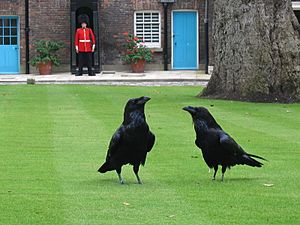
Since 1990, the Tower of London has been cared for by Historic Royal Palaces. This charity gets no money from the government or the Crown. In 1988, the Tower of London became a World Heritage Site. This recognizes its global importance and helps protect it. However, new skyscrapers nearby have made people worry it might be added to the Heritage in Danger List.
The remains of the medieval palace opened to the public in 2006. Visitors can explore rooms restored to how they looked when kings and queens lived there. The Constable of the Tower is still the highest position. But the Resident Governor handles daily tasks. At least six ravens are kept at the Tower at all times. It is believed that if they leave, the kingdom will fall. The Yeomen Warders care for them. The earliest known mention of a Tower raven is from 1883. Besides ceremonial duties, the Yeoman Warders give tours. Over 2.7 million people visited the Tower of London in 2015.
The Crown Jewels
The tradition of keeping the Crown Jewels at the Tower of London probably started with Henry III (1216–1272). The Jewel House was built just for the royal items. These included jewels, gold and silver plates, and symbols of royalty like the crown, scepter, and sword. If the monarch needed money, these treasures could be used as a loan. The treasure gave the monarch power over the nobles, so it was guarded very carefully.
A new job was created: "keeper of the jewels, armouries and other things." This was a well-paid job. In Edward III's reign (1312–1377), the keeper was paid 12 pence a day. The job grew to include buying royal jewels, gold, and silver. It also involved hiring royal goldsmiths and jewelers.
In 1649, during the English Civil War, the Jewel House contents were sold off. Metal items were melted down. The crowns were "totally broken and defaced." When the monarchy was restored in 1660, only a 12th-century spoon and three ceremonial swords remained. The rest of the Crown Jewels had to be remade.
In 1669, the Jewel House was torn down. The Crown Jewels moved to Martin Tower. People could pay to see them. This led to a famous event two years later. Colonel Thomas Blood tried to steal them. Blood and his helpers tied up the Jewel House keeper. They got their hands on the Imperial State Crown, Scepter, and Orb. But the keeper's son showed up unexpectedly and raised the alarm. The Crown Jewels are now on display in the Jewel House in the Waterloo Block.
The Royal Menagerie (Zoo)
The Royal Menagerie (a collection of wild animals, like a zoo) is first mentioned during Henry III's reign. In 1251, officials were told to pay for the King's polar bear. It was probably a gift from Haakon IV of Norway. The bear got a lot of attention when it went fishing in the Thames. In 1254, officials were told to help build an elephant house at the Tower. We don't know the exact spot of the medieval menagerie. But the lions were kept in the barbican called Lion Tower.
The royal collection grew with gifts from other countries. This included three leopards from Frederick III, the Holy Roman Emperor. By the 1700s, the menagerie was open to the public. Entry cost three half-pence or a cat or dog to feed the lions. A famous animal was Old Martin, a large grizzly bear. George III received it as a gift in 1811. In 1828, there were over 280 animals of at least 60 types. The last animals left in 1835. They were moved to Regent's Park after a lion was accused of biting a soldier. The Keeper of the Royal Menagerie could live in the Lion Tower for life. So, even after the animals left, the Lion Tower was not torn down until the last keeper died in 1853.
In 2011, an exhibition at the Tower featured wire animal sculptures by Kendra Haste.
Ghosts of the Tower
Anne Boleyn was executed in 1536 for treason against Henry VIII. Her ghost is said to haunt the chapel of St Peter ad Vincula, where she is buried. This haunting is remembered in a 1934 song. Other reported ghosts include Henry VI, Lady Jane Grey, Margaret Pole, and the Princes in the Tower.
In January 1816, a guard outside the Jewel House claimed to see a ghost of a bear. He reportedly died of fright a few days later. In October 1817, the Keeper of the Crown Jewels, Edmund Lenthal Swifte, said he saw a glowing ghost in the Jewel House. He said it floated over his wife's shoulder. She cried out, "Oh, Christ! It has seized me!" Night staff at the Tower have also reported other scary, shapeless things more recently.
Images for kids
-
A recreation of Edward I's bedchamber in the river-side St Thomas's Tower above Traitors' Gate.
-
Two of the ravens
-
Skull of a Barbary lion that was kept at Tower of London, Natural History Museum
See also
 In Spanish: Torre de Londres para niños
In Spanish: Torre de Londres para niños


